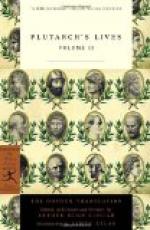as Euripides says of Herakles, which line we may well apply to Kimon according to the account of him given by Stesimbrotus. While he was still young he was accused of incest with his sister. Indeed Elpinike is not recorded as having been a respectable woman in other respects, as she carried on an intrigue with Polygnotus the painter; and therefore it is said that when he painted the colonnade which was then called the Peisianakteum, which is now called the Painted Porch, he introduced the portrait of Elpinike as Laodike, one of the Trojan ladies. Polygnotus was a man of noble birth, and he did not execute his paintings for money, but gratis, from his wish to do honour to his city. This we learn from the historians and from the poet Melanthius, who wrote—
“With deeds of heroes
old,
He made our city
gay,
In market-place and porch,
Himself the cost
did pay.”
Some historians tell us that Elpinike was openly married to Kimon and lived as his wife, because she was too poor to obtain a husband worthy of her noble birth, but that at length Kallias, one of the richest men in Athens, fell in love with her, and offered to pay off the fine which had been imposed upon her father, by which means he won her consent, and Kimon gave her away to Kallias as his wife. Kimon indeed seems to have been of an amorous temperament, for Asterie, a lady of Salamis, and one Mnestra are mentioned by the poet Melanthius, in some playful verses he wrote upon Kimon, as being beloved by him; and we know that he was passionately fond of Isodike, the daughter of Euryptolemus the son of Megakles, who was his lawful wife, and that he was terribly afflicted by her death, to judge by the elegiac poem which was written to console him, of which Panaetius the philosopher very reasonably conjectures Archelaus to have been the author.
V. All the rest that we know of Kimon is to his honour. He was as brave as Miltiades, as clever as Themistokles, and more straightforward than either. Nor was he inferior to either of them in military skill, while he far surpassed them in political sagacity, even when he was quite a young man, and without any experience of war. For instance, when Themistokles, at the time of the Persian invasion, urged the Athenians to abandon their city and territory, and resist the enemy at Salamis, on board of their fleet, while the greater part of the citizens were struck with astonishment at so daring a proposal, Kimon was seen with a cheerful countenance walking through the Kerameikus with his friends, carrying in his hand his horse’s bridle, which he was going to offer up to the goddess Athena in the Acropolis, in token that at that crisis the city did not need horsemen so much as sailors. He hung up the bridle as a votive offering in the temple, and, taking down one of the shields which hung there, walked with it down towards the sea, thereby causing many of his countrymen to take courage and




